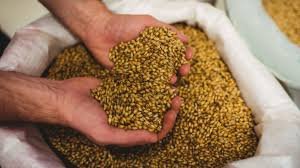Top 10 Barley Producing Countries in the World
Barley, one of the oldest cultivated grains, continues to be a crucial crop globally. Its versatility in use, from brewing beer to being a staple food, makes it an essential agricultural commodity. In recent years, certain countries have emerged as key players in barley production, significantly influencing the global market. Here, we delve into the top 10 barley-producing countries in the world.
- Russia: Leading the pack is Russia, with its vast expanses of fertile land and favorable climate for barley cultivation. The country’s robust agricultural sector contributes significantly to its position as the top barley producer.
- Germany: Known for its high-quality barley varieties, Germany secures the second spot on the list. The country’s expertise in barley cultivation, coupled with advanced agricultural practices, ensures a consistent supply of this valuable grain.
- France: Renowned for its rich agricultural heritage, France boasts a strong presence in the global barley market. The country’s diverse climate zones allow for the cultivation of various barley varieties, catering to different market demands.
- Ukraine: With its fertile black soil and extensive agricultural land, Ukraine emerges as a key player in barley production. The country’s strategic location and favorable agro-climatic conditions contribute to its growing influence in the global agricultural landscape.
- Australia: Down Under, Australia’s barley production thrives in its temperate regions. The country’s modern farming techniques and investment in research and development ensure a steady output of high-quality barley for both domestic consumption and export.
- Canada: Known for its vast barley fields stretching across the prairies, Canada ranks among the top barley-producing nations. The country’s stringent quality standards and efficient agricultural practices uphold its reputation as a reliable barley supplier.
- Turkey: Bridging the gap between Europe and Asia, Turkey holds a significant position in the global barley market. The country’s diverse agro-climatic zones and centuries-old farming traditions contribute to its steady barley production.
- United States: With its massive agricultural sector, the United States remains a key player in barley production. Favorable growing conditions in states like Idaho and Montana ensure a steady supply of barley for various industrial and culinary purposes.
- United Kingdom: Despite its smaller land area, the United Kingdom maintains a noteworthy presence in barley cultivation. The country’s temperate climate and agricultural innovation drive its barley production, supporting its brewing and livestock industries.
- Argentina: Rounding off the top 10 list is Argentina, known for its fertile Pampas region ideal for barley cultivation. The country’s agricultural prowess and export-oriented approach contribute to its role as a significant barley producer.
In conclusion, the top 10 barley-producing countries play a crucial role in shaping the global barley market. Their combined efforts ensure a steady supply of this versatile grain, meeting diverse consumer demands worldwide.

Why this News is important:
Barley production holds immense significance in the realm of global agriculture. Understanding the dynamics of the top barley-producing countries is vital for various stakeholders, including agricultural policymakers, traders, and farmers. Here’s why this news is important:
- Market Insights: Knowledge of the leading barley-producing nations provides valuable insights into market trends, helping stakeholders make informed decisions regarding trade, investment, and agricultural policies.
- Food Security: Barley serves as a staple food for millions worldwide and is crucial for food security in many regions. Monitoring production trends in key producing countries ensures adequate supply to meet the nutritional needs of populations globally.
- Economic Implications: The prominence of certain countries in barley production has significant economic implications. Understanding the role of these nations in the global market helps anticipate price fluctuations and trade dynamics, affecting various industries and economies.
- Sustainability: As sustainability becomes increasingly important in agriculture, monitoring barley production practices in top-producing countries is essential. Efforts to enhance productivity while minimizing environmental impact are crucial for the long-term viability of barley cultivation.
- Trade Dynamics: Barley is a traded commodity, with international markets playing a crucial role in its distribution. Knowledge of the top producing countries facilitates an understanding of trade dynamics, including exports, imports, and market competitiveness.
Historical Context:
Barley cultivation has a long and rich history dating back to ancient civilizations. Understanding the historical context provides insights into the evolution of barley production and its significance today.
- Ancient Origins: Barley was among the first crops cultivated by early human societies, particularly in regions of the Middle East and Asia. Its hardy nature and adaptability made it an essential food source for ancient civilizations such as the Sumerians and Egyptians.
- Medieval Europe: Barley remained a staple crop throughout medieval Europe, where it was used for brewing beer and as a dietary staple for both humans and livestock. Its cultivation techniques evolved over time, contributing to agricultural advancements in the region.
- Colonial Expansion: The colonial era witnessed the spread of barley cultivation to new regions, including North America and Australia. European settlers introduced barley farming to these territories, shaping local agricultural landscapes and economies.
- Industrialization and Modernization: The industrial revolution brought significant changes to barley production, with advancements in machinery, irrigation, and crop management practices. This era marked the transition from traditional farming methods to more mechanized and efficient techniques.
- Globalization: In the modern era, globalization has transformed the barley market, with production becoming increasingly interconnected across continents. Trade liberalization, technological innovation, and shifts in consumer preferences have influenced the geographic distribution of barley cultivation.
5 Key Takeaways from “Top 10 Barley Producing Countries in the World”:
| Serial Number | Key Takeaway |
|---|---|
| 1 | Russia leads the world in barley production, leveraging its vast agricultural resources. |
| 2 | Germany and France are prominent European players, known for their quality barley varieties. |
| 3 | Australia and Canada excel in barley production due to favorable climates and modern farming practices. |
| 4 | Ukraine and Argentina emerge as key contributors, benefiting from fertile land and export-oriented strategies. |
| 5 | Understanding the global distribution of barley production is crucial for agricultural stakeholders and policymakers. |
Important FAQs for Students from this News
1. What are the main uses of barley globally?
- Barley is primarily used for brewing beer, as a key ingredient in various food products, and as animal feed.
2. How does climate influence barley production?
- Barley thrives in temperate climates with adequate moisture and sunlight. Regions with such conditions tend to have higher yields of barley.
3. Why is Russia the leading barley producer?
- Russia’s vast agricultural land, favorable climate, and advanced farming practices contribute to its dominance in barley production.
4. What role does barley play in global food security?
- Barley is a staple food for many populations worldwide, providing essential nutrients and contributing to food security in regions where it is consumed.
5. How does barley production impact the economy of producing countries?
- Barley production has significant economic implications, including employment generation, export revenue, and contributions to GDP, particularly in top-producing countries.
Some Important Current Affairs Links
















